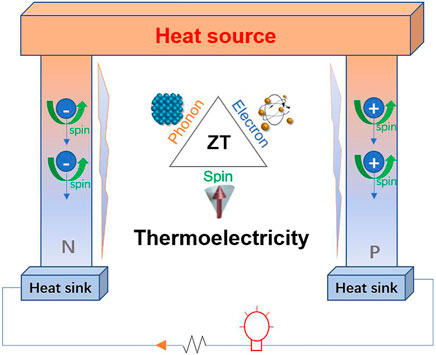Editorial: A Brief Perspective to the Development of Emerging Thermoelectric Materials
- 1International Laboratory for Quantum Functional Materials of Henan, School of Physics and Microelectronics, Zhengzhou University, Zhengzhou, China
- 2Institute of Materials Science, Technische Universität Darmstadt, Darmstadt, Germany
- 3State Key Laboratory of Advanced Design and Manufacturing for Vehicle Body, College of Mechanical and Vehicle Engineering, Hunan University, Changsha, China
Editorial on the Research Topic
A Brief Perspective to the Development of Emerging Thermoelectric Materials
The ever-growing energy issue brings forth a strong impetus for efficient harvesting and conversion of heat into electrical energy, where thermoelectric (TE) materials play a pivotal role. Such materials provide a simple and environmentally friendly solution for the thermo-electric conversion, applicable for automobiles and high-power electrical appliances which produce lots of waste heat.
The development of high-performance TE materials and their optimization have attracted intensive attention in the materials science and energy communities, with one of the main goals to boost the TE figure of merit
In recent years, two-dimensional (2D) materials have been extensively investigated for fabricating miniaturized electronic devices, where the thermal management and thermo-electric conversion become essential. Interestingly, an increasing number of 2D materials have been predicted to have the potential applications in TE via high-throughput calculations (Jia et al., 2020; Sarikurt et al., 2020). Electronic fitness function as a new descriptor to estimate TE performance of semiconductors is usually used for screening novel TE materials. Among them, the monolayer GeS2 has been recently confirmed as a good candidate for 2D materials with weak interlayer coupling from theory and experiment study (Yan et al., 2022). In this topic, Wang et al. systematically investigated the TE performance of monolayer GeS2, including both the electronic and the thermal transport properties (Wang et al.). As compared with other typical TE monolayer materials, the monolayer GeS2 exhibits excellent electronic transport properties but a relatively high lattice thermal conductivity of 5.71 W m−1 K−1 at 500 K. Thus, an unsatisfactory ZT value of 0.23 is reached. Such a low ZT value indicates that beyond the electronic transport properties, it is necessary to also consider the thermal transport properties through high-throughput calculations to screen the thermoelectric materials with excellent performance.
This collection on the investigation of TE materials or the closely related thermal conductivity provides a comprehensive perspective, which is expected to stimulate research inspiration in the TE field and advance the fundamental understanding of TE performance. Due to the role of electrons, spins, and the lattice vibrations (phonon) and their couplings have a significant effect on the thermal transport and thermoelectric performance (Figure 1), more novel strategies are expected to boost TE performance in future, such as spin modulation, etc. Notably, the Rashba effect modulation is expected to optimize the electronic and the thermal transport properties simultaneously. In addition, for searching high performance TE materials through high-throughput calculations and machine learning techniques, new descriptors are also deserved to be explored, such as by constructing from existing descriptors of bandgap, effective mass, etc.
Author Contributions
All authors listed have made a substantial, direct, and intellectual contribution to the work and approved it for publication.
Conflict of Interest
The authors declare that the research was conducted in the absence of any commercial or financial relationships that could be construed as a potential conflict of interest.
Publisher’s Note
All claims expressed in this article are solely those of the authors and do not necessarily represent those of their affiliated organizations, or those of the publisher, the editors and the reviewers. Any product that may be evaluated in this article, or claim that may be made by its manufacturer, is not guaranteed or endorsed by the publisher.
References
Jia, T., Feng, Z., Guo, S., Zhang, X., and Zhang, Y. (2020). Screening Promising Thermoelectric Materials in Binary Chalcogenides Through High-Throughput Computations. ACS Appl. Mater. Inter. 12, 11852–11864. doi:10.1021/acsami.9b23297
Sarikurt, S., Kocabaş, T., and Sevik, C. (2020). High-Throughput Computational Screening of 2D Materials for Thermoelectrics. J. Mater. Chem. A 8 (37), 19674–19683. doi:10.1039/D0TA04945J
Keywords: thermoelectricity, thermal transport, optimization, SPIN, high-through computation
Citation: Qin Z, Zhang H and Qin G (2022) Editorial: A Brief Perspective to the Development of Emerging Thermoelectric Materials. Front. Mater. 9:803853. doi: 10.3389/fmats.2022.803853
Received: 28 October 2021; Accepted: 09 February 2022;
Published: 28 February 2022.
Edited by:
Hanfeng Liang, Xiamen University, ChinaReviewed by:
Xiangming Xu, King Abdullah University of Science and Technology, Saudi ArabiaQiu Jiang, University of Electronic Science and Technology of China, China
Copyright © 2022 Qin, Zhang and Qin. This is an open-access article distributed under the terms of the Creative Commons Attribution License (CC BY). The use, distribution or reproduction in other forums is permitted, provided the original author(s) and the copyright owner(s) are credited and that the original publication in this journal is cited, in accordance with accepted academic practice. No use, distribution or reproduction is permitted which does not comply with these terms.
*Correspondence: Hongbin Zhang, hongbin.zhang@tu-darmstadt.de; Guangzhao Qin, qin.phys@gmail.com
 Zhenzhen Qin
Zhenzhen Qin Hongbin Zhang
Hongbin Zhang Guangzhao Qin
Guangzhao Qin